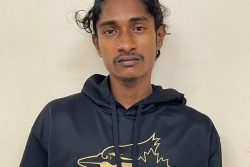(Trinidad Guardian) Schizophrenia is a chronic and severe mental disorder that affects how a person thinks, feels and behaves. So when Roger “Bubbles” Nagessar charged at police with a cutlass in his hand, relatives felt the police could have taken pity and shot him in the legs.
Instead, Nagessar, 44, died at the San Fernando General Hospital after being shot several times in the leg and chest Wednesday night.
A report stated that around 8.30 pm Wednesday, Ste Madeleine police and the Rapid Response Unit responded to a report that Nagessar was walking in the road with a cutlass. He had been acting violently and throwing bottles at his neighbours’ homes along Herrera Street, Friendship Village, San Fernando.
When officers arrived and called Nagessar out of his house, where he lived alone, he emerged with a cutlass. Despite the officers’ instructions to drop the cutlass three times Nagessar refused. He reportedly said: “Like they want to execute my son.” He then walked toward the officers and they fired six shots at him. He was taken to the San Fernando General Hospital (SFGH) where he died.
A relative, who asked not to be identified, said yesterday that while the officers were within their rights to defend themselves they could have shot Nagessar in his leg. He said Nagessar was an outpatient of the SFGH and behaved well when he took his medication. However, he often forgot to do so and that was when things got bad. For example, he noted that Nagessar had no children.
Six years ago when Nagessar suffered his first violent episode he also walked the streets with a cutlass. On that occasion police also responded but he was shot in the legs. He was shown leniency when he appeared in the court and was not sentenced to prison or fined.
But on Wednesday night the relative said the officers did not fire a warning shot. A non-lethal shot or non-lethal weapons such as tasers or pepper spray, the relative added, could have made a difference in this case.
Since 2014, the Police Social Welfare Association has been lobbying for the use of non-lethal weapons that would reduce the number of deadly encounters with mentally ill people as well as injury to officers.
“In my view and the view of many other people, excessive force was used because of the areas they shot him. They are the professionals in this area, but I am looking at it as they shot a person who is mentally ill,” the relative said.
“I know that as police officers their first response is self-preservation. I’m not saying that their lives were not threatened, but a level of professional approach is within their duty and I think there are certain areas on a person they can target that would not damage vital organs.”
An autopsy was expected to be done yesterday and relatives were to meet on whether they will file a complaint with the Police Complaints Authority.
There have been many encounters between police and mentally ill citizens that have ended in the citizens’ deaths in recent years.
Last July, Kevin Lewis, 29, who relatives said was mentally ill, was shot dead after he allegedly attacked a group of Port-of-Spain police. The officers had responded to a report that he was threatening his neighbours and damaging properties in St Ann’s.
Last April, Colin Roopchand, 26, who suffered from bipolar disorder, was shot dead by police while in his house. It was reported that he attacked his mother. When the officers arrived, they called on him to drop the knife he was holding. Instead, he lunged at them and was shot in his chest.
In June 2017, Daniel Paul, 23, who was mentally ill, was shot dead by police who responded to a report that he was throwing stones at passing vehicles in Ste Madeleine. He attempted to attack the officers and was shot twice.
In March 2017, Paul Marchan, an outpatient of the St Ann’s Hospital who also suffered from bipolar disorder, was shot dead by police after he allegedly attacked them with a razor blade near his Diego Martin home. Similarly, residents reported to police that he was terrorising the neighbourhood.
Deyalsingh: Time for tasers
Association of Psychiatrists secretary Dr Varma Deyalsingh is calling on the authorities to issue police officers with tasers and rubber bullets which can be used to subdue mentally ill persons who act out violently. He said training must also be given to officers to target non-critical areas of the body if they have to use their firearms.
Deyalsingh said the majority of people suffering from schizophrenia are not violent and tend to isolate themselves. However, there are cases where a schizophrenic may develop a delusion whereby they feel threatened and because of paranoia, he or she may act out violently
“We keep having these issues where the mentally ill person is on the receiving end. There have been three cases within the last year and a half where police used extreme force,” Deyalsingh told the T&T Guardian.
“We have to understand that there are going to be more mentally ill people in our streets so there are going to be more cases for the police to deal with. Our challenge is how we can train the police officers to face the mentally ill person in that situation. “
He added, “If the encounter may lead to death or physical damage to members of the public, police may have to use excessive force. We are hoping that the police officers can be trained to bring down those aggressive mentally ill persons with non-lethal means.”
Last year, 26 police officers from the Southern Division, Central Division, Community Policing Secretariat and South Western Division participated in the South West Regional Health Authority’s fifth Psychological and Mental Health First Aid training session. The training was designed to equip officers with the knowledge to recognise and respond to persons with mental illnesses while facilitating the referral process for specialised treatment.
However, the police still do not have tasers and other non-lethal weapons for use as part of their equipment.








